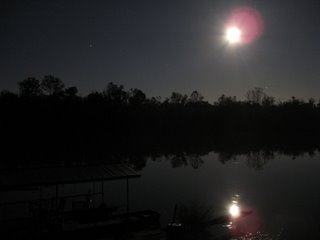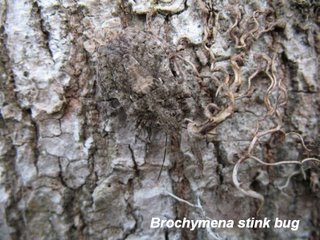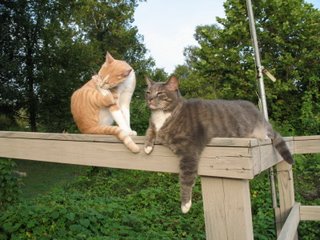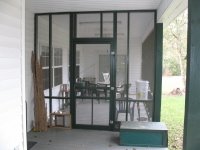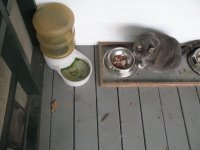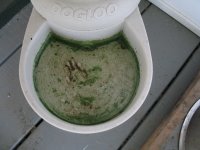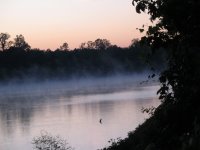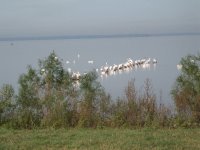[The pictures here are intended to show some of the moods of the Basin. The sunrises, sunsets, foggy mornings, bright clouds and rainstorms are all part of it. To me the wavy reflection on the water is like the constantly changing face of the swamp.]

Some time ago, actually it was February 21 of this year, I posted a poem that I wrote in 2002 entitled “Atchafalaya Is”. I wrote the poem to remind myself of why I think the Atchafalaya is important, both as a physical entity and as a concept. I said I wanted to try to post a short piece based on each line of the poem, explaining why that particular thought had meaning for me. I begin this now, with the first line - "Atchafalaya is: beyond ownership".
When I firs
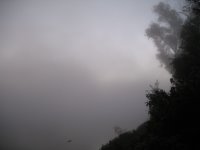
t met the thing that is the Atchafalaya Basin I was about 10 years old. This would have been 58 years ago, and some of the major changes that now define the Basin had not yet fully taken place. There were still deep water bayous, and much of Grand Lake was still a lake. By then you couldn’t see across the lake because of the sandbars and willow trees, but you could still travel by boat from one side to the other without much trouble. Even in low water it wasn’t much trouble.
It’s hard to say why some things affect us in the way they do, and why they affect some people and not others. The man who introduced me to the swamp was named Julian Gajan, but everyone called him Rut. He was a beer delivery man in New Iberia, and his route included my father’s restaurant. Because he chose to include me in his frequent

trips into the Basin, I began a relationship with the swamp that I barely understand myself. For me the first trips into the Basin were like meeting someone for the first time and knowing without knowing that this person comes from the same place you do. You expect them to be warmed by the same things that warm you, and cooled by the same things too. This was how I felt about the Basin from the first time I saw it, or this is at least how I remember feeling. It was a long time ago, but a few things don’t fade much, and this is one that has never faded.
Whatever caused the effect that the swamp had on me, no person can own. And that’s what I meant by the first line of the poem. Oh sure, people can claim title to the trees and to the land.
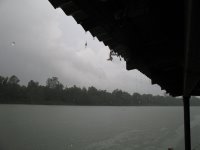
That’s not at all what I mean. There was a bond between the trees and the water and me, and that bond was caused by what Plato would have called the form of the Atchafalaya. The form is not something you can touch, but it is something you can feel. We would go out from Charenton in Rut’s little bateau and I couldn’t get enough of what he could tell me about the water and the fish and the birds and the snakes and everything else that the swamp had to offer. You could
feel being in the swamp. You could smell it. You could eat its fish and that felt good. You could be cold in a rainstorm and even that felt good. You could fail to catch fish sometimes, and even that felt good. You could just be there, and that felt good.

So, it is the potential for the Atchafalaya Basin to affect people that is beyond ownership. It is available to anyone open to its message, as I was open to it as a boy a long time ago. Others I have met have been affected this way too. Still others are feeling it for the first time as I write this. And for those who might feel it in the future I say that the concept, the true power, of the Atchafalaya Basin has always been beyond ownership, and it will never be for sale.
On a more local note, I am changing stageons on my trotline right now. After a low water season the swivels corrode out and come apart. There are quite a few shrimp in the traps so I’ll try t

o put a few more catfish and gous in the freezer before the high water starts.
As sunsets go, this one was fine.
The river is at 7.7 on the Butte La Rose gauge, falling to 6.4 by Friday. The Mississippi and Ohio are both falling for the time being, but it is raining up there.
Rise and Shine, Jim
 Just a quick thing to record some news. This morning my friend Rusty, the man who fishes the big nets for buffalo, caught a tarpon in the Atchafalaya River. He was raising nets about seven miles (on a level with Catahoula) below Butte La Rose and he caught this strange looking fish. He didn’t recognize it right away, having never caught one in his nets before. But it had the big scales, and Rusty is always looking for interesting things, and so he saved it and brought it in. He called the Dept. of Wildlife and Fisheries and they sent a biologist to meet him at the landing in Simmesport, and they confirmed that it was indeed a seven pound (estimate) tarpon.
Just a quick thing to record some news. This morning my friend Rusty, the man who fishes the big nets for buffalo, caught a tarpon in the Atchafalaya River. He was raising nets about seven miles (on a level with Catahoula) below Butte La Rose and he caught this strange looking fish. He didn’t recognize it right away, having never caught one in his nets before. But it had the big scales, and Rusty is always looking for interesting things, and so he saved it and brought it in. He called the Dept. of Wildlife and Fisheries and they sent a biologist to meet him at the landing in Simmesport, and they confirmed that it was indeed a seven pound (estimate) tarpon.




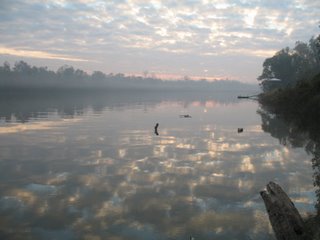




 strong to hold the line – at which point I would remove the line. Then the water would usually continue to rise to its high point for the year sometime around April, and fall slowly thereafter. Well, last year was different. The very low water in 2005 continued beyond the time it usually rises, and it never did rise very much. It actually never forced me to remove the line, I just quit fishing it for a couple weeks and then it receded again. I believe the high for last spring was about 11 feet instead of the usual 18 feet or more.
strong to hold the line – at which point I would remove the line. Then the water would usually continue to rise to its high point for the year sometime around April, and fall slowly thereafter. Well, last year was different. The very low water in 2005 continued beyond the time it usually rises, and it never did rise very much. It actually never forced me to remove the line, I just quit fishing it for a couple weeks and then it receded again. I believe the high for last spring was about 11 feet instead of the usual 18 feet or more.







